San Francisco — Two University of California—San Francisco (UCSF) researchers have recently published a paper that reveals how humans are able to selectively hear a single speaker while tuning out other sounds in crowded or noisy environments. The study appears in the journal Nature.
To understand how selective hearing works in the brain, UCSF neurosurgeon Edward F. Chang, MD, a faculty member in the UCSF Department of Neurological Surgery and the Keck Center for Integrative Neuroscience, and UCSF postdoctoral fellow Nima Mesgarani, PhD, worked with three patients who were undergoing brain surgery for severe epilepsy.
Part of this surgery involves pinpointing the parts of the brain responsible for disabling seizures. The UCSF epilepsy team finds those locales by mapping the brain’s activity over a week, with a thin sheet of up to 256 electrodes placed under the skull on the brain’s outer surface or cortex. These electrodes record activity in the temporal lobe—home to the auditory cortex.
“The combination of high-resolution brain recordings and powerful decoding algorithms opens a window into the subjective experience of the mind that we’ve never seen before,” Chang said in the press release.
In the experiments, patients listened to two speech samples played to them simultaneously in which different phrases were spoken by different speakers. They were asked to identify the words they heard spoken by one of the two speakers.
The authors then applied new decoding methods to “reconstruct” what the subjects heard from analyzing their brain activity patterns. The authors found that neural responses in the auditory cortex only reflected those of the targeted speaker. They found that their decoding algorithm could predict which speaker and even what specific words the subject was listening to based on those neural patterns. In other words, they could tell when the listener’s attention strayed to another speaker.
“The algorithm worked so well that we could predict not only the correct responses, but also even when they paid attention to the wrong word,” Chang said.
The new findings show that the representation of speech in the cortex does not just reflect the entire external acoustic environment, but instead just what we really want or need to hear.
The findings represent a major advance in understanding how the human brain processes language, with immediate implications for the study of impairment during aging, attention deficit disorder, autism, and language learning disorders.
Chang added that researchers could one day use this knowledge for neuroprosthetic devices for decoding the intentions and thoughts from paralyzed patients who cannot communicate.
Revealing how our brains are wired to favor some auditory cues over others may even inspire new approaches toward automating and improving how voice-activated electronic interfaces filter sounds in order to properly detect verbal commands.
"Selective cortical representation of attended speaker in multi-talker speech perception" by Nima Mesgarani and Edward F. Chang appears in the April 19, 2012 issue of the journal Nature.



